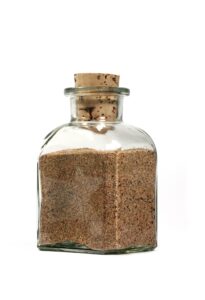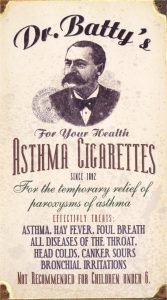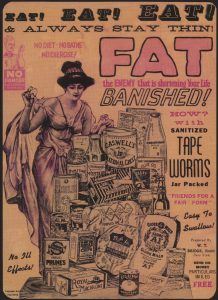 While Bile Beans were initially pitched as a cure for biliousness, the influenza epidemic of 1899 was too good an opportunity to miss. Horrible though the ‘flu was, a lot of people would recover after a week or so anyway, and it was an easy matter for quacks to point to cases where the recovery coincided with the taking of their medicine.
While Bile Beans were initially pitched as a cure for biliousness, the influenza epidemic of 1899 was too good an opportunity to miss. Horrible though the ‘flu was, a lot of people would recover after a week or so anyway, and it was an easy matter for quacks to point to cases where the recovery coincided with the taking of their medicine.
A leaflet enclosed with the Beans stated that they were also a cure for cirrhosis of the liver, blackheads, and all female complaints, and later they were mainly targeted at women, using glamorous pictures that now appear incongruous with the unattractive product name. Although the leaflet said that the Beans did not include mercury, bismuth, or aloes, they did contain aloin – an aloe extract with laxative properties that is no longer considered safe because of its potential side effects. The other ingredients were cardamom, peppermint oil and wheat flour, with a black gelatine coating. (More Secret Remedies, BMA, 1912)
THE INFLUENZA PLAGUE
_____________
A NEW SPECIFIC
Mr. A. S. Selwyn, of No. 4 Emily-street, Warrickville, N.S.W., says that Charles Forde’s Bile Beans pulled him round from a terrible attack of influenza when all else failed. Interviewed by a representative regarding his recovery he said:— “Not long since I was attacked most severely with influenza: such a hold did it get upon me that I was obliged to leave my work, and I was confined to the house for over a week. Anyone at my place of business will verify this statement, as I have often complained to them, and they know full well that I have suffered keenly. I went through all the stages of this miserable complaint, being assailed continually with a cold and headache, pains in various parts of my body, and a general disinclination for exertion of any kind. While confined to the house I tried various remedies, but all to no effect. This was the state of things when I happened to have Charles Forde’s Bile Beans brought under my notice, and I thought I would try them. Well, Sir, I must say I was surprised at the amount of good they did me; not only did they completely cure me of influenza, but also of several other complaints, notably biliousness and indigestion, from which I suffered. Immediately after I began taking them I commenced to experience relief, and in a surprisingly short time I was completely cured. Since that time I have not had the slightest return of any of my complaints, and I ascribe my speedy and thorough cure to Bile Beans for Biliousness, and I heartily recommend them as a grand cure for influenza.”
The reader should bear in mind that what Bile Beans will do for one they will do for others. They have proved themselves an undoubted specific for biliousness, indigestion, constipation, rheumatism, sciatica, lumbago, gout, influenza, debility, dyspepsia, headache, insomnia, liver complaints, and piles. At this season of the year the liver’s action is very bad, causing chills, numbness of the hands, and in such cases Bile Beans will be found very effective. Bile Beans are obtainable from chemists generally, or the Bile Beans manufacturing Company will forward direct from their London Depot, 119 and 120, London Wall, one box for 1s 1½d or 2s 9d (large box holds three small). Please mention this paper if you are writing.
Source: The Northern Echo, (Darlington) Thursday 16 Nov 1899
The story behind the Beans went that an Australian scientist, Charles Forde, had discovered an ancient aboriginal remedy. The actual inventor was a Canadian called Charles E Fulford (I don’t know if he was connected to the Fulfords of Dr Williams’ Pink Pills fame), and the story about the aborigines was completely made up. Although this was revealed during a 1905 court case where Fulford sued the proprietor of an imitation product, the Bile Beans became very popular in the 20th century and were still on sale in the 1980s.
Thank you to teaandcakes on Flickr for the 1940s advertising picture



I just received a lovely tin of Bile Beans for Christmas – and, after some effort, managed to open the tin, and lo! it was still full of Bile Beans! All in their little twists of paper… See here http://www.flickr.com/photos/essers/sets/72157623361057206/
Brilliant present – I would love to receive things like that for Christmas!